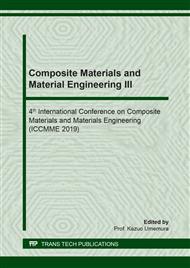p.276
p.285
p.292
p.298
p.304
p.313
p.319
p.325
p.331
Kinetics and Isotherm Studies of Methyl Orange Adsorption Using Polyethyleneimine-Graphene Oxide Polymer Nanocomposite Beads
Abstract:
Nanocomposite beads containing 2% chitosan (CS), 2% polyethyleneimine (PEI), and 1,500 ppm graphene oxide (GO) were synthesized for the removal of methyl orange (MO) from water. Characterization of the CS-PEI-GO beads using Fourier transform infrared spectroscopy (FTIR) and scanning electron microscopy (SEM) showed favorable adsorbent properties as given by the presence of numerous surface functional groups and a porous structure. Effects of different parameters such as pH, contact time, and initial concentration on the percentage removal of MO and adsorption capacity of the beads were investigated by performing batch adsorption experiments. MO removal of more than 85% was achieved by the beads across a wide pH range. Kinetic studies were performed and a pseudo-second order kinetic equation with R2 of 0.9999 was obtained. Furthermore, adsorption equilibrium data for MO were best described by the Toth isotherm model (R2 = 0.9644), suggesting multilayer adsorption on heterogeneous adsorption sites with a maximum adsorption capacity of 421.51 mg/g. Finally, FTIR and SEM analyses after adsorption confirmed the presence of MO on the surface of the beads and revealed an intact and stable structure. Overall, the excellent adsorption capability and multi-functionality demonstrated in this study show great potential of the synthesized material for wastewater treatment applications.
Info:
Periodical:
Pages:
304-310
Citation:
Online since:
May 2019
Price:
Сopyright:
© 2019 Trans Tech Publications Ltd. All Rights Reserved
Share:
Citation:


